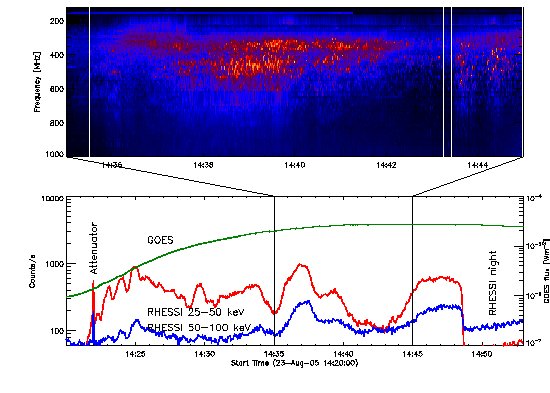Do solar decimetric spikes originate in coronal X-ray sources?
From RHESSI Wiki
m |
m |
||
| Line 33: | Line 33: | ||
So, what is going on? The X-ray and radio emission do occur in the same flare. The spike observations indicate the presence of non-thermal electrons, possibly originating from an additional, spatially separated energy release in the high corona. Considering that the spikes occur during the impulsive phase, there appears to be a causal link, direct or indirect, between the spikes and the main flare energy release near or inside the X-ray coronal source. | So, what is going on? The X-ray and radio emission do occur in the same flare. The spike observations indicate the presence of non-thermal electrons, possibly originating from an additional, spatially separated energy release in the high corona. Considering that the spikes occur during the impulsive phase, there appears to be a causal link, direct or indirect, between the spikes and the main flare energy release near or inside the X-ray coronal source. | ||
| - | + | A paper on this observation by Battaglia \& Benz is in print as a letter at Astronomy and Astrophysics. | |
'''Biographical Note:''' Arnold Benz is Professor at ETH Zurich, Switzerland. Marina Battaglia is a Leverhulme Research Fellow at the University of Glasgow, Scotland. | '''Biographical Note:''' Arnold Benz is Professor at ETH Zurich, Switzerland. Marina Battaglia is a Leverhulme Research Fellow at the University of Glasgow, Scotland. | ||
Revision as of 07:16, 9 June 2009
| Nugget | |
|---|---|
| Number: | |
| 1st Author: | Arnold Benz |
| 2nd Author: | Marina Battaglia |
| Published: | |
| Next Nugget: | {{{next_nugget}}} |
| Previous Nugget: | {{{previous_nugget}}} |
| List all | |
Introduction
In the standard solar flare scenario, a large number of particles (electrons and protons) are accelerated in the solar corona. Radiative signatures of these particles are found in X-rays and radio wavelenghts, telling us that the particles are non-thermally distributed in energy. Assuming that the same distribution of particles causes both, X-ray and radio emission, one would expect a tight relation of the two emission types. Indeed, millisecond spikes have been found to have a high temporal association rate with hard X-rays.
But what about the spatial relation? Sticking to the picture of a coronal acceleration site, one may expect coronal X-ray emission and radio spikes to originate from the same positions.
Observations
By combining RHESSI observations (positions of X-ray sources) with Phoenix-2 data (identification of radio spikes) and observations from the Nancay Radio Heliograph (locations of the radio emission in 4 discrete frequencies) in a particularly well observed limb event, we can find - at least one - answer to the above question. Figure 1 shows the radio spectrogram and the thermal and non-thermal X-ray light curves of the event. The spikes occured in the impulsive phase, when the soft X-ray emission was still rising. However, the radio emission is not clearly correlated in time with the details of the hard X-ray lightcurve.

 band produced by thermal emission.
band produced by thermal emission.Now let us have a look at the spatial relations. Figure 2 shows GOES/SXI images overlaid with RHESSI contours and the location of the centroid position of Nancay radio data at the three highest frequencies.

Figure 2 shows that the spike sources do not coincide with neither the footpoints nor the coronal source. The Nugget reader should be informed that sizes of radio sources are always very large, in our case larger than the beams, having sizes of typically more than 2 arcminutes. The radio source size is generally supposed to be the result of scattering in the corona. As the signal-to-noise ratios are up to 100, the centroid can still be determined to within typically less than 10 arcsecs. The error bars in Fig. 2 show the standard deviation of the radio peak centroid distribution. The distribution of the centroids is well confined compared to the source size, indicating that the scattering is relatively stable in time. Scattering moves the position of the radio emission to generally higher altitude.
The mean displacement of the radio centroids from the coronal hard X-ray source ranges from 79 arcsec (at 327 MHz in time interval 1) to 97 arcsec (410 MHz in time interval 2). In all cases, this exceeds the half width of the beams. Furthermore, the radio centroid positions are not found radially above the coronal X-ray source. In fact, the low and high frequencies are displaced from each other horizontally, not radially. These properties are difficult to explain with scattering alone. The data suggest that decimetric spikes do not originate from coronal X-ray flare sources, contrary to previous expectations.
Conclusions
So, what is going on? The X-ray and radio emission do occur in the same flare. The spike observations indicate the presence of non-thermal electrons, possibly originating from an additional, spatially separated energy release in the high corona. Considering that the spikes occur during the impulsive phase, there appears to be a causal link, direct or indirect, between the spikes and the main flare energy release near or inside the X-ray coronal source.
A paper on this observation by Battaglia \& Benz is in print as a letter at Astronomy and Astrophysics.
Biographical Note: Arnold Benz is Professor at ETH Zurich, Switzerland. Marina Battaglia is a Leverhulme Research Fellow at the University of Glasgow, Scotland.
| RHESSI Nugget First Author | Arnold Benz + |
| RHESSI Nugget Second Author | Marina Battaglia + |